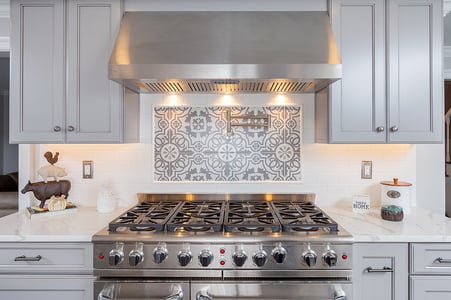Transitional Kitchen: Balancing Classic and Contemporary Styles
When it comes to kitchen design, the transitional style has gained immense popularity for its ability to harmoniously blend classic and contemporary elements. This versatile design aesthetic strikes a balance between traditional elegance and modern simplicity, resulting in a kitchen that is timeless, functional, and visually appealing. In this blog post, The Cabinet Coach will explore the latest trends and techniques to help you create a transitional kitchen that seamlessly combines the best of both worlds.

1. Merging Classic and Contemporary Materials: One of the key aspects of a transitional kitchen is the combination of different materials. Pair traditional elements such as natural stone countertops or subway tile backsplashes with sleek stainless steel appliances or minimalist cabinet hardware. This fusion of classic and contemporary materials creates a visually striking and balanced look.
2. Neutral Color Palette:Transitional kitchens often feature a neutral color palette that enhances the timeless and calming atmosphere. Opt for shades like whites, creams, grays, and taupe to create a backdrop that allows other design elements to shine. You can add pops of color through accessories, such as vibrant dishware or decorative accents.
3. Shaker-style Cabinets: Shaker-style cabinets are a popular choice for transitional kitchens. These cabinets, with their clean lines and simple profiles, effortlessly bridge the gap between traditional and modern design. Choose cabinets in classic colors like white, cream, or light gray for a timeless appeal.
4. Mixed Metals: Incorporating mixed metals in your transitional kitchen adds a touch of contemporary flair. Combine brushed nickel, polished chrome, or stainless steel finishes for hardware, faucets, and light fixtures. The mix of metallic accents creates visual interest while maintaining a cohesive and balanced look.
5. Versatile Lighting:Good lighting is essential in any kitchen, and in a transitional kitchen, it can play a pivotal role in setting the tone. Opt for a combination of recessed lighting, pendant lights, and under-cabinet lighting to create layers of illumination. Consider using statement pendant lights with classic or modern designs as a focal point.
6. Timeless Flooring:When selecting flooring for a transitional kitchen, aim for a classic yet durable option. Hardwood floors in rich tones like oak or walnut are a popular choice. Alternatively, ceramic or porcelain tiles in neutral hues can provide a timeless and easy-to-maintain flooring solution.
7. Transitional Accents:Add transitional elements to your kitchen through accessories and decor. Incorporate upholstered seating with clean lines and subtle patterns. Introduce a blend of classic and contemporary artwork, decorative vases, or pendant lighting to enhance the transitional aesthetic.
Creating a transitional kitchen involves the art of blending classic and contemporary elements in a harmonious and visually appealing way. By merging materials, incorporating a neutral color palette, choosing shaker-style cabinets, mixing metals, utilizing versatile lighting, selecting timeless flooring, and adding transitional accents, you can achieve a kitchen that seamlessly marries tradition with modernity. Embrace the flexibility and elegance of transitional design, and enjoy a kitchen that stands the test of time while offering a contemporary edge.
Call our team at (856) 213-9414 or schedule an online consultation HERE
